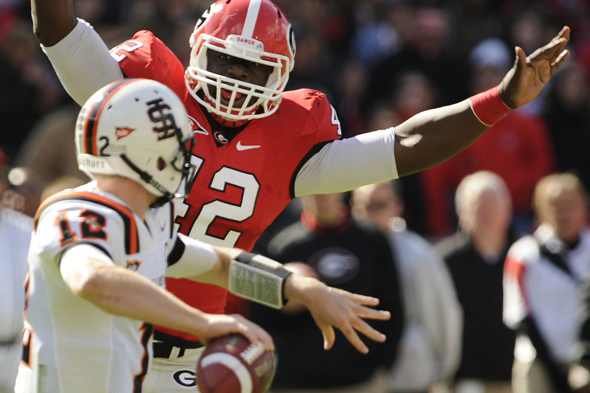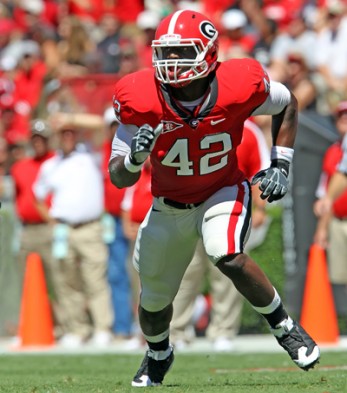
Around season’s end, Pete Carroll said that he waited too long to put Raheem Brock alongside Chris Clemons on the ends of Seattles four-man front after the season-ending knee injury to Red Bryant halfway through the year. Before Brock and Clemons combined to give the Seahawks a very dynamic edge rush combination, Kentwan Balmer and Junior Siavii took Bryants place with varying degrees of success.
Balmers ineffectiveness and Siaviis own season-ending injury gave Brock his shot. Carroll finally eradicated the Leo hybrid defense that didnt work in Bryants absence. Then a more traditional defense led the way through important late-season wins and an unexpected playoff win over the New Orleans Saints.
But Bryants injury history brings concerns. The team of Clemons and Brock will be 30 and 33 years old, respectively, when the 2011 season begins (if, indeed, the 2011 season begins on time). As we saw near the end of Patrick Kerneys career, pass rushers tend to plummet when age takes its toll. Clearly, younger and more versatile options are needed.
Among the draft-eligible players bringing interest from the Seahawks is Georgia outside linebacker/end Justin Houston, who was reported to be preparing for a visit to the VMAC (along with several other trips to other NFL facilities).
The 6-foot-3, 270-pound Houston has excelled in three- and four-man fronts in the various defensive schemes. He amassed 20 sacks (16 solo), 115 tackles (65 solo), 38 tackles for loss (30 solo), 17 quarterback hurries, five passes defensed, and two forced fumbles. In 2010 alone, he had 67 tackles, 18.5 tackles for loss, and 10 sacks. It is this versatility that makes him an especially intriguing prospect for a Seahawks defense that applies the principles of three-and four-man fronts about equally.
Especially for his size, Houston put on a real show at the scouting combine – his

1.62-second 10-yard split was just .05 of a second slower than those of Von Miller and Dontay Moch – two outside speed linebackers that Houston outweighed by 25 pounds. His 36 ½-inch vertical jump, the highest at his position, speaks to explosiveness off the snap, and his 40-yard dash, three-cone, and shuttle times were all exceptional for a bigger player. Of course, the question always stands – do these attributes show up on game tape?
Pros: Houston has great blast-and-turn speed when he sets up in a wider look past the outside shoulder of the tackle; his 10-yard split is represented in the fact that he seems to get up to full speed before his blocker can get his hands up and his first kick-step out of the way. Exhibits a natural low angle when he turns the corner. Closes in well when he has to catch up to a quarterback stepping up in the pocket. Against tackles slower to turn, he turns on the jets and exploits that lack of agility.
Gets a good hand-punch going to push the tackle off as he turns the corner. On running plays, he backs off the rush quickly and starts sifting through blockers inside as quickly as he can, and he’s fast enough to occasionally get a tackle for loss that way. Doesn’t lose penetrative ability in different fronts; he appears to be as disruptive as a 3-4 endbacker as he is in a straight 4-3. Can play on either side, hand up or hand down – this is his primary asset.
Cons: Gets past sub-par blockers quickly, but will need to further develop his hand moves to get past NFL blockers. No consistent ability in coverage per se, but Houston has the agility to develop some zone blitz moves. When it comes to diagnosing misdirection, or plays that extend outside after an inside look, Houston will tend to plant himself in one place as opposed to flowing naturally to the ball. He developed in this area in 2010, but Tim Tebow made him look silly in the previous season with bootlegs and option reads when the Bulldogs played the Gators. Not a turnover machine, but a good form tackler who can close in for open-field stops. Houston was suspended in 2009 for reportedly violating his school’s substance abuse policy.
Conclusion: Georgia’s coaches did Houston a huge favor when they switched to a 3-4 defense in 2010; NFL teams can see how Houston does in just about every possible front, and teams playing a lot of hybrid fronts should find him especially appealing. He could excel as an end in a 4-3 scheme once he gets coached up to defend plays that aren’t straight-ahead, or as a 3-4 edge rusher in the James Harrison mold, where his specific lack of versatility won’t be a problem as he gains experience.
The wider Houston splits out, the more effective he seems to be, and with his speed all the way through the play, he could be especially devastating in a multi-front scheme — like the one run by the Seahawks.
At this time, Houston is projected to go in the late first round by most — he wouldn’t be a huge reach with the 25th pick if that’s where the Seahawks decided to take him.
NFL Comparison: Charles Johnson, Carolina Panthers

1 Comment
I think he’d good pick if he’s the best athlete available. Really need to address the offensive line, but then wouldn’t that be done better in the later rounds, especially with the left tackle spot filled?